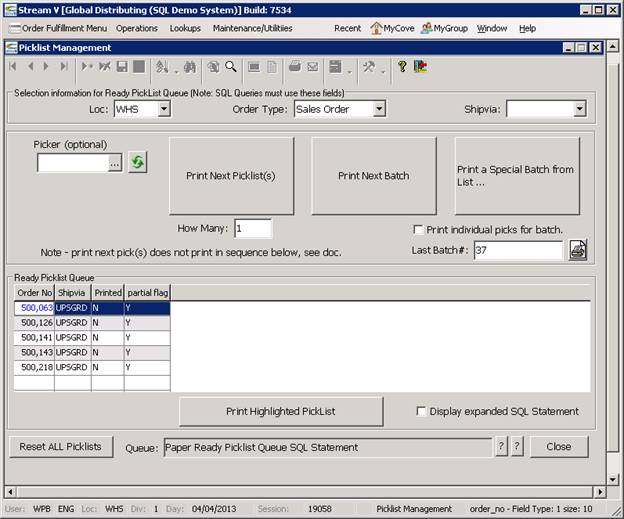Picklist Management
The Picklist Management Program is used to print picking lists or “picklists” for the sales and loaner orders that are being fulfilled from your warehouse locations. Picklists are used to process and complete or invoice Warehouse Shipments and Special Order Shipments.

Picklists are internal documents. Picklists specify the items and quantities that should be shipped out against each order. The items that are printed on each picklist are based on the current status and the schedule date in each sales order line and other information from the sales order (such as the partial flag). Each picklist lists the items and quantities to be picked for the order and the bin locations from which each item should be picked. Picklists may also contain text or comment information such as specific picking instructions. These comments or notes can be entered and edited by order entry personnel.
As each picklist is produced, the system assigns a unique “ticket” number to the printed order line items, and it allocates or commits the appropriate quantity of each item from one or more of the bin locations for the item.
The system will block you from editing a sales order while a printed picklist exists for the order . This prevents changes to the order between the time the pick is generated and the pick is invoiced. The system also will not allocate additional inventory to an order that has a picklist printed for it. If you need to edit an order and a printed picklist exists for the order, the picklist must be reset before the order can be modified.
Once a picklist has been produced for an order, the picklist document is used to physically pick the items to be shipped out from the appropriate bins in the warehouse. Once the items for each order have been picked, the unique order and ticket combination from the picklist document is used to load the Order Invoicing program with the items and quantities that should be shipped out.
As each Picklist is invoiced, the system resets the printed flag and clears the ticket number from the printed order. If the order still contains open lines after the shipment has been processed, the order can be edited again.
The following links can be used to view more information about Picklist Processing.
Picklist Processing
The Picklist Management Program allows you to print picklists for the orders that can be shipped out of your warehouses using two different methods.
• On Demand - The Picklist Management program can be used to automatically print one or more picklists, based on the selection information that has been entered into the program. When this option is used (by selecting the number of picks to be printed and pressing the Print Next Picklist(s) button), the system looks at the Warehouse location, Order type and optional ShipVia that have been selected, and it then prints the specified number of picks based on those selections and the number in the How Many Window. If a specific shipvia is selected, and the on demand option is used, the system will print the smaller of the number of printable picks for the shipvia, or the number of picklists specified in the How Many Window.
• Print Selected Picklist – The lower section of the Picklist Management program is used to display the sales orders that are available for shipment. This section of the program is referred to as the “Ready Picklist Queue”. The orders that are displayed in the Ready Picklist Queue are based on the selections that have been made in the Selection Information section of the program. You may select and print a picklist for a single order by highlighting the desired order in this section of the program and pressing the Print Selected Picklist Button.
The Picklist Management program can be used to print normal or Type S sales orders, and it can also be used to print Loaner (Type L) sales orders.
The type of order that is displayed by and can be printed from the Picklist Management program is based on the Order Type that is selected in the program. The Picklist Management program defaults the order type to Sales Order and you must select the Loaner Order Type to display any Loaner orders that are ready for processing.
Sales Orders or type S orders are used for sales of product to your customers. As a Type S sales order is completed, the system automatically creates an invoice for the items shipped out and it posts the invoice to the general ledger.
Shipper or Loaner orders (order type L) are used when you wish to send items to your customers or another entity at no charge. When a shipper or loaner order is invoiced, the system creates records in the Pending file for the items that are shipped out. Later the Pending records can be used to either invoice the customer for the goods (if they decide to purchase them), to return the goods to stock (if they are returned by the customer) or write the items off (if they need to be charged to an expense or cost of sales account. Loaners are also used when returning goods to a vendor for credit and/or replacement using the Return to Vendor System.
More:
 Zoom - Sales Order Header Detail Panel
Zoom - Sales Order Header Detail Panel
 Expand - Sales Order Lines Lookup
Expand - Sales Order Lines Lookup